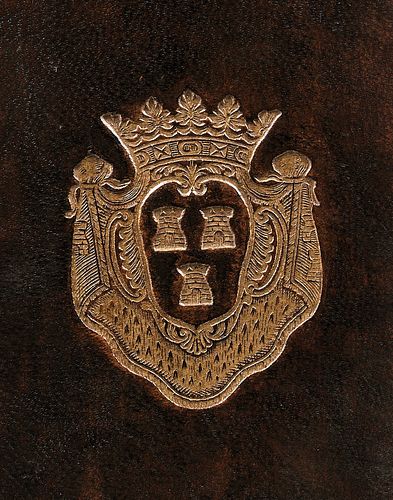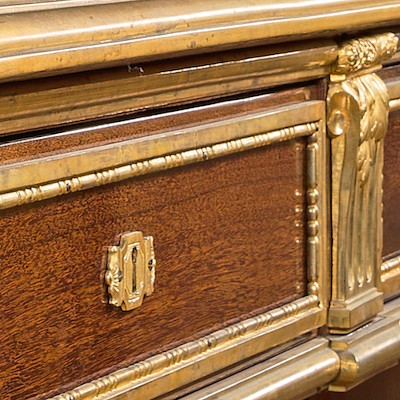BOUND WITH THE ARMS OF THE MARQUISE DE POMPADOUR.
Lot 18
Categories
Estimate:
EUR€500 - EUR€600
$537.63 - $645.16
Absentee vs Live bid
Two ways to bid:
- Leave a max absentee bid and the platform will bid on your behalf up to your maximum bid during the live auction.
- Bid live during the auction and your bids will be submitted real-time to the auctioneer.
Bid Increments
| Price | Bid Increment |
|---|---|
| No bidding increment | |
About Auction
Catalog Only
By Beaussant Lefèvre & Associés
Dec 13, 2022
Set Reminder
2022-12-13 08:00:00
2022-12-13 08:00:00
America/New_York
Bidsquare
Bidsquare : Furniture and Works of Art from the Anne Aymone and Valery Giscard d’Estaing Collections
https://www.bidsquare.com/auctions/beaussant-lef-vre-associ-s/furniture-and-works-of-art-from-the-anne-aymone-and-valery-giscard-d-estaing-collections-11505
Beaussant Lefèvre & Associés contact@beaussantlefevre.com
Beaussant Lefèvre & Associés contact@beaussantlefevre.com
- Lot Description
BOUND WITH THE ARMS OF THE MARQUISE DE POMPADOUR. - COLLECTION OF VARIOUS PIECES serving the history of Henry III, king of France and Poland. In Cologne, by Pierre du Marteau. 1693. In-12, 717 pp, brown morocco, smooth spine with fleurons and garnet title, triple gilt fillet framing the boards with fleurons and coats of arms in the center, inner gilt border, gilt edges (18th century binding).
INCREASED EDITION, printed at a fictitious address. Collection originally established by Pierre Dupuy and published in 1660 in Leiden by Jean Elzevier, containing then 4 pieces, which was the subject of several enlarged editions in 1663 (5 pieces), 1666 (6 pieces), and here 1693 (7 pieces).
CHARGES AGAINST THE COURT OF VALOIS TO DISCREDIT THE FRENCH KINGDOM. The successive publications
successive publications of this collection are to be linked to Louis XIV's policy toward Protestants: the decision in 1660 to apply the Edict of Nantes "to the hilt," the Dutch War (1672-1678), the War of the League of Augsburg (1688-1697), and the Revocation of the Edict of Nantes (1693).
It includes:
- [L'ESTOILE (Pierre)]. Journal du regne de Henry III. Excerpts from the Registre-journal of Pierre de L'Estoile (1546-1611), audiencier en la Chancellerie, highlighting the corruption of the Court's morals. It was originally published in 1621 on a manuscript copy of Pierre Dupuy (1582-1651), a friend of the author. This first diffusion of the text, partial and expurgated, was taken again in the edition of 1660 of the present collection, by Louis Servin (1555-1626), lawyer general at the Parliament of Paris, and several times republished. The complete work of Pierre de L'Estoile was published only in the 21st century.
- CAYET (Pierre Victor Palma)]. The satyric divorce, or The loves of the queen Marguerite de Valois. One of the sources of the black legend of queen Margot, this libel originally appeared in the 1660 edition of the present collection. Protestant converted to Catholicism, Pierre Victor Palma Cayet (1525-1610) became a priest and was appointed professor of Hebrew at the Royal College.
- CONTI (Louise de Lorraine, princess of). L'Alcandre, or The loves of the king Henry the Great. Satire of the amorous misconduct of the first Bourbon, this novel with a controversial attribution, had originally appeared in 1651, before being integrated in the 1660 edition of the present collection. Daughter of Duke Henri de Guise, Louise de Lorraine (1588-1631) was ardently desired by an aging Henri IV.
- AUBIGNÉ (Théodore Agrippa d'). The Confession of M. de Sancy. Originally published after his death, in the 1660 edition of the present collection, this is one of his most vigorous pamphlets, directed against Nicolas Harlay, sieur de Sancy (1546-1629), diplomat in the service of Henri III and superintendent of Finances under Henri IV, who had abjured Protestantism; with a broadening of perspective which makes it a violent charge against the papacy and Catholicism in general.
- LE DUCHAT (Jacob). Remarks on La confession de Sanci. First edition. Protestant lawyer and philologist, Jacob Le Duchat was exiled after the Revocation of the Edict of Nantes.
- ROHAN (Catherine de Parthenay, viscountess of). Apology for the king Henry the fourth. A woman of letters and mathematician of the reformed religion, the viscountess of Rohan took an active part in the inter-religious struggles, notably during the siege of La Rochelle, and her son Henri de Rohan became the leader of the Protestant party. Piece added in the 1666 edition.
- WONDERFUL DISCOURSE on the life of Catherine de Medicis. Supposedly attributed to Henri Estienne, this pamphlet contributed powerfully to the black legend of Catherine de Medici. It was originally published in 1575 and then, republished several times, was integrated in the 1663 edition of the present collection.
EXAMPLE WITH THE ARMS OF THE MARQUISE DE POMPADOUR (OHR, pl. n° 2399, iron n° 4, in the small
format with variant).
Provenance: Pierre-François Godard de Beauchamps, secretary to the marshal de Villeroy, author of Recherches sur les théâtres published in 1735, whose library was purchased by Madame de Pompadour en bloc (handwritten bookplate on the title). - Handwritten notation in blue ink "n° 194". - Heilbronn (ex-libris vignette).



 EUR
EUR CAD
CAD AUD
AUD GBP
GBP MXN
MXN HKD
HKD CNY
CNY MYR
MYR SEK
SEK SGD
SGD CHF
CHF THB
THB











